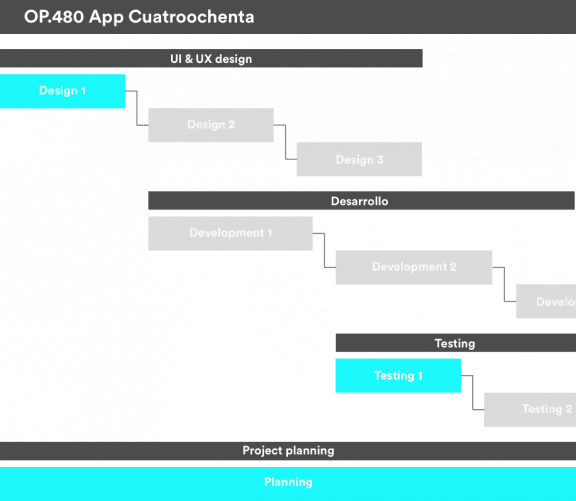With the aim of improving their quality, Cuatroochenta has evolved its way of working overtime and has adopted different work methodologies, adapting to the needs of projects and clients, always seeking excellence.
Throughout this trajectory, we have worked with closed budget contracts, hourly contracts or outsourcing, among others.
Nowadays, the projects led by Cuatroochenta are challenging and innovative, and require continuous updates; therefore, in order to improve their quality and maintain excellence, Cuatroochenta has developed its own work methodology called Continuous Development, which consists of iterative and incremental progress in projects, breaking them down into small iterations composed of a limited set of functionalities, thus allowing the delivery of operational parts in a very short period of time. This provides a high degree of control and monitoring and, in turn, allows flexibility so that projects can evolve or pivot to adapt to the market and the business.
Key advantages of this work methodology
Improved quality
The Continuous Development methodology is based on carrying out constant iteration stages that increase the final quality of the project by facilitating continuous improvement.
In addition, thanks to this constant interaction between the client and the technology partner, peace of mind is also increased by being able to see constant feedback on the project in real time, with the opportunity to periodically suggest improvements. This results in an improved end product, due to repeated reviews and continuous improvements.
Ability to respond
It allows responses to changes that occur in the project environment as well as the market quickly and efficiently.
Error reduction
This methodology drastically reduces errors and the possibility of costly corrections by continuously validating them.
Realistic delivery dates
By making estimates of delivery dates based on the iterations and not of the project as a whole, the precision of the global estimate is increased, allowing a more realistic final delivery date.
Aims of this work methodology
This work methodology pursues five main objectives:
1. To provide clients with the flexibility to undertake their projects in a synchronised way, based on their own planning and needs.
2. To offer a system that provides control over scope, budget, planning and execution, to reduce the uncertainty that every technological project entails.
3. To improve the response capacity and flexibility of our clients in the face of new technological challenges.
4. To guarantee the continuity of the operation and the client's industrial property over their projects and the reduction of risks.
5. To enhance the technological know-how of our clients through collaboration and the transmission of knowledge.
How are these projects executed?
At the beginning of the project, our Business Analysis team will carry out a requirements analysis that will define the scope of the project. To undertake the development, the total functionality will be divided into small iterations, which will be further divided into different deliverable betas and tasks that allow the client to test the development carried out gradually, validating the results and minimising concept errors.
The concatenation of various iterations in a continuous and planned workflow will allow the definition of the Work Roadmap that may vary depending on the needs of the project at any particular time, as well as the feedback obtained from users. Once the scope of an iteration has been defined, the functional detail will be sent to the client together with the costs involved. When the customer approves, in whole or in part, the iteration, it will be added to the production planning based on the approved time estimates.
As a result of this planning exercise, a Gantt chart will be created with the start and end dates of the iteration development. In addition, the client will have direct access to the planning and project information system in Jira to monitor the progress and execution of each iteration in real time.
The execution of an iteration consists of three phases:
1) Interface design and user experience
In the first instance, the UX/UI team designs the interface and user experience, delivering interactive mock-ups that will serve to validate with the client that the proposed interface includes the previously defined functional approach.
2) Programming
During the development of the iteration, different intermediate deliveries will be carried out, so that the client can see and test the solution, thus being up to date with progress at all times, and providing feedback at the same time as the development team continues to advance.

3) Quality assurance
Cuatroochenta's QA system is designed to guarantee quality throughout the development cycle and ensure that software projects comply with the established requirements.
What roles are involved in a Continuous Development project?
Each project is assigned, by default, the following roles oriented to the analysis, management and quality control of the project:
These individuals will intervene, to a greater or lesser degree depending on the phase of the project and its characteristics, but in any case they will be assigned to monitor the project from different perspectives. Sometimes different roles can fall to the same person (for example, a Project Leader and Technical Manager).
Thanks to the new Continuous Development methodology, it is possible to iterate in a more agile way so that the final result is of exceptional quality and does not differ from what those responsible for Encuentra24 expect and desire to have. In addition, it provides total oversight and control of the project, of the tasks that are being carried out, and what phase they are in. In this way, it is possible to suggest improvements in real time without having to wait for the project to be fully developed. For this reason, we believe that the flexibility of the Continuous Development work methodology has allowed Encuentra24 to adapt in record time to the changes that have occurred due to Covid-19.